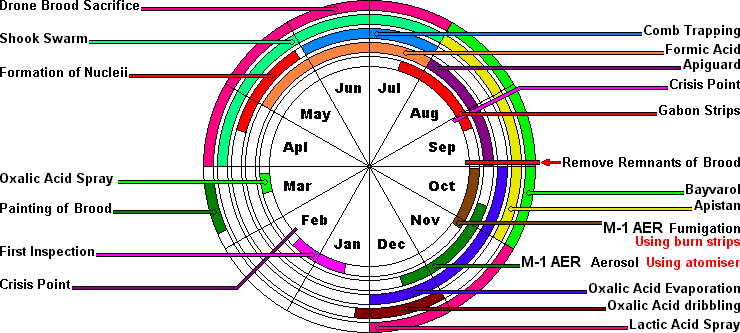Varroa Detection
Natural Oils
Varroa Control
Varroa Detection
Varroa Life Cycle
Artificial Swarm for Varroa Control
|
|
|
|---|
|
Varroa Detection Natural Oils Varroa Control Varroa Detection Varroa Life Cycle Artificial Swarm for Varroa Control |
Varroa Treatment Methods |
|---|
Numerous types of treatment have been tried in many countries of the world. These treatments fall into several categories which are listed below. The aim is to reduce the varroa population to a minimum by the time that brood rearing stops and the bees are ready for winter. Additional treatments may be needed in spring before supers are required. There is a risk of drone infertility if spring treatments are required.
The Czech Research Institute have produced a range of treatments that can be applied or have better effectiveness at various times of the year. The Czech program started in 1978 and I have been following it closely since about 1982.
The Czech Institute was founded in 1919 and has been at Dol, 20 km north of Prague, since 1922. In 1997 the Institute was privatised, research continues and they have support from the Czech government and various EU governments. They cooperate and are associated with the Czech Beekeepers union, Czech state veterinary administration and the Austrian professional beekeepers association. Their testing laboratory has accreditation to ISO EN 45001. The diagram below was inspired by one of their publications and represents varroa treatment possibilities throughout the year, including some that were not in the original Czech schedule.

'Hard' Chemicals
Usually these are veterinary medicines... With defined treatment
instructions. It is wise to follow these instructions as resistance
to the particular chemicals may be speeded up by using the wrong
dose or honey may be contaminated if the advised timing is altered.
Bayvarol was the first example to be licenced in UK with Apistan being the second. The rest of this list is either not licenced in UK, but is a licenced treatment in some other countries or has certification that has lapsed. Taktivar and Gabon PA 92 are licenced and used in the Czech Republic. Cekafix is licenced in Germany. The licence for Folbex VA has lapsed (it is not recommended as wax residues build up quickly).
'Soft' Chemicals
This category contains Formic Acid,
Oxalic Acid and
Lactic Acid as well as various
Essential Oils.
Thymol Crystals
and ApiGuard also fall into
this category. Although the organic acids are a 'soft' treatment, they are
extremely corrosive and need care and protective clothing when used.
'Physical' or Bio technical Methods
'Integrated Pest Management' 'IPM'
'Non Medicinal Curative Substances'
This peculiar term has arisen in the UK to cover non licenced items
in the above lists.
Herbal treatments... Powdered coltsfoot has been used. This is a powder and works to cause a lack of grip in the varroa mite's feet just like other powders, but there is said to be some medical effect as well. This requires more research.
I asked Vladimir Vesely about a rumour that I had heard, about painting brood with an amitraz emulsion. He replied...
painting with amitraz could not be recommended from the hygienic point of view (dosing is too high in comparison with fumigation). Painting with formic acid in our experiments proved low effectiveness. In formic acid are active its vapours. The amount of formic acid by painting is too small for making optimal concentration of vapours in air. But we have experimented with relatively small areas of brood. The results with larger areas may be better.
Best regards, Vesely, BRI Dol
In a previous Email asking about the details of brood Painting. He replied...
Painting of brood is a method of treatment of bee colonies in early spring when the area of capped brood is very small (less than 10 sq dm). Cappings of the brood are penetrated with water emulsion of fluvalinate ( 125 mg in 50 ml water). Penetration is made by painting with small paintbrush or a cotton wool roll. Only cappings are painted. Consumption of emulsion is very small, no more than 3 mg of fluvalinate are carried out into the colony. Fluvalinate penetrated in cappings acts against varroa mite and his developing stages into the brood cell as well as against varroa females on bees walking on the surface of capped brood. Cappings (carriers of fluvalinate) together with rests of fluvalinate are removed by bees. Risk of residues is negligible.
Best regards, V. Veselý
Bee Res.Inst. Dol
252 66 Libcice n. Vlt,
Czech Republic
D.A.Cushman.
Page created summer 2001
Page archived 05/11/2020
Written... Summer 2001, Revised... 22 November 2001, Revised... 19 & 24 February 2002, Revised... 18 October 2002, Upgraded... 22 May 2006, Further Upgraded... 29 August 2006,
|